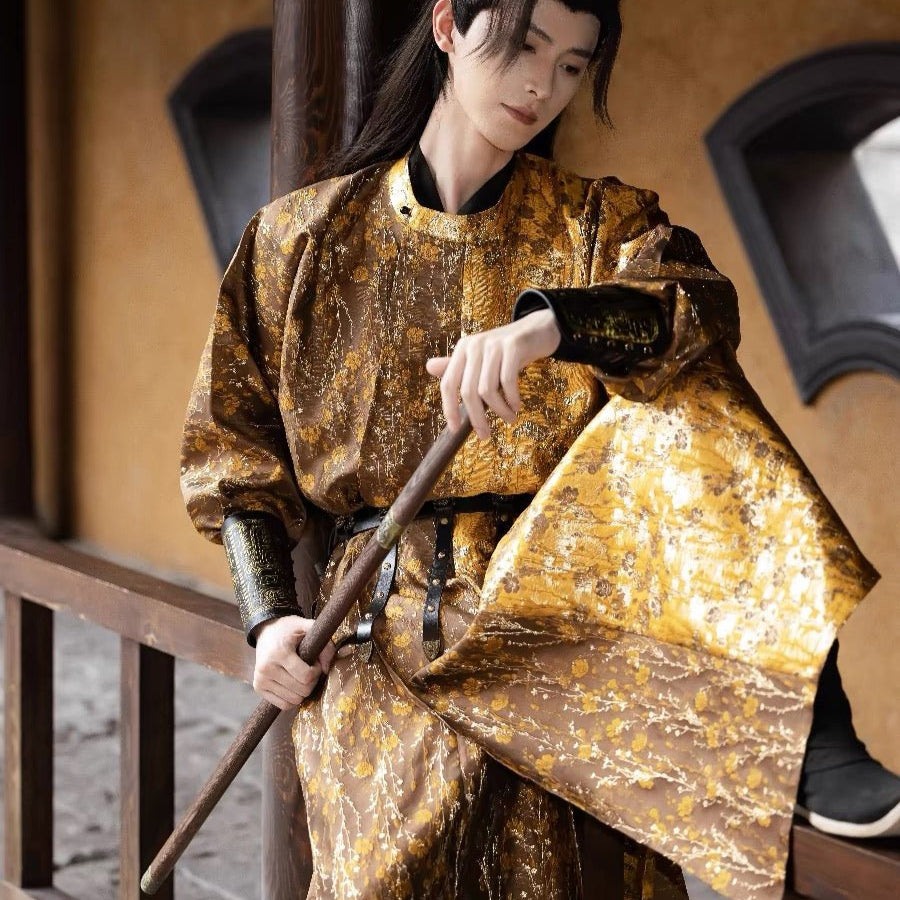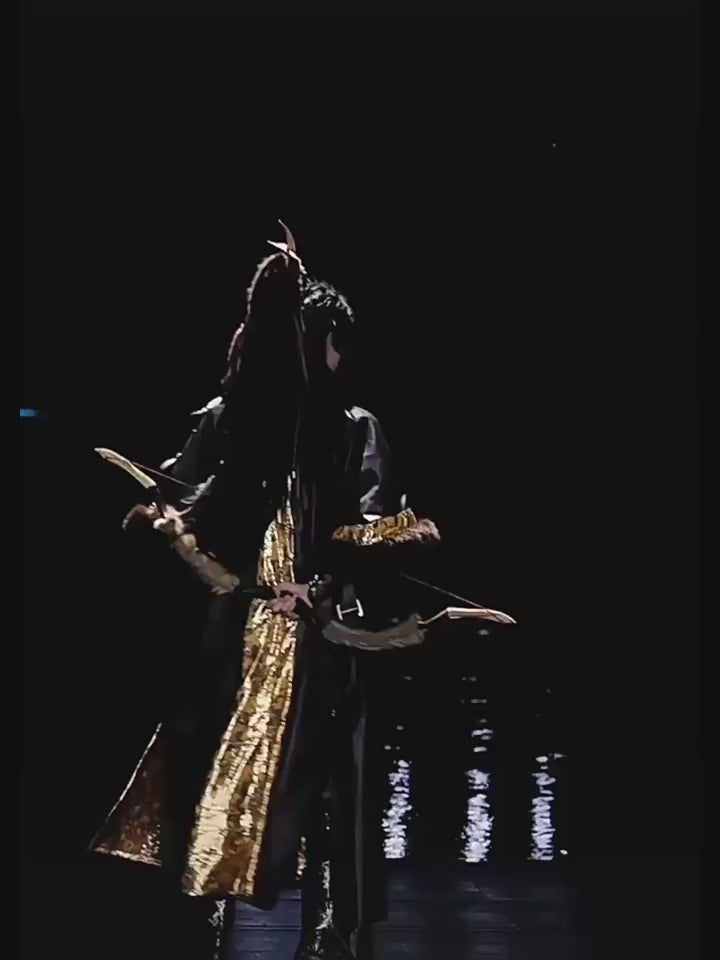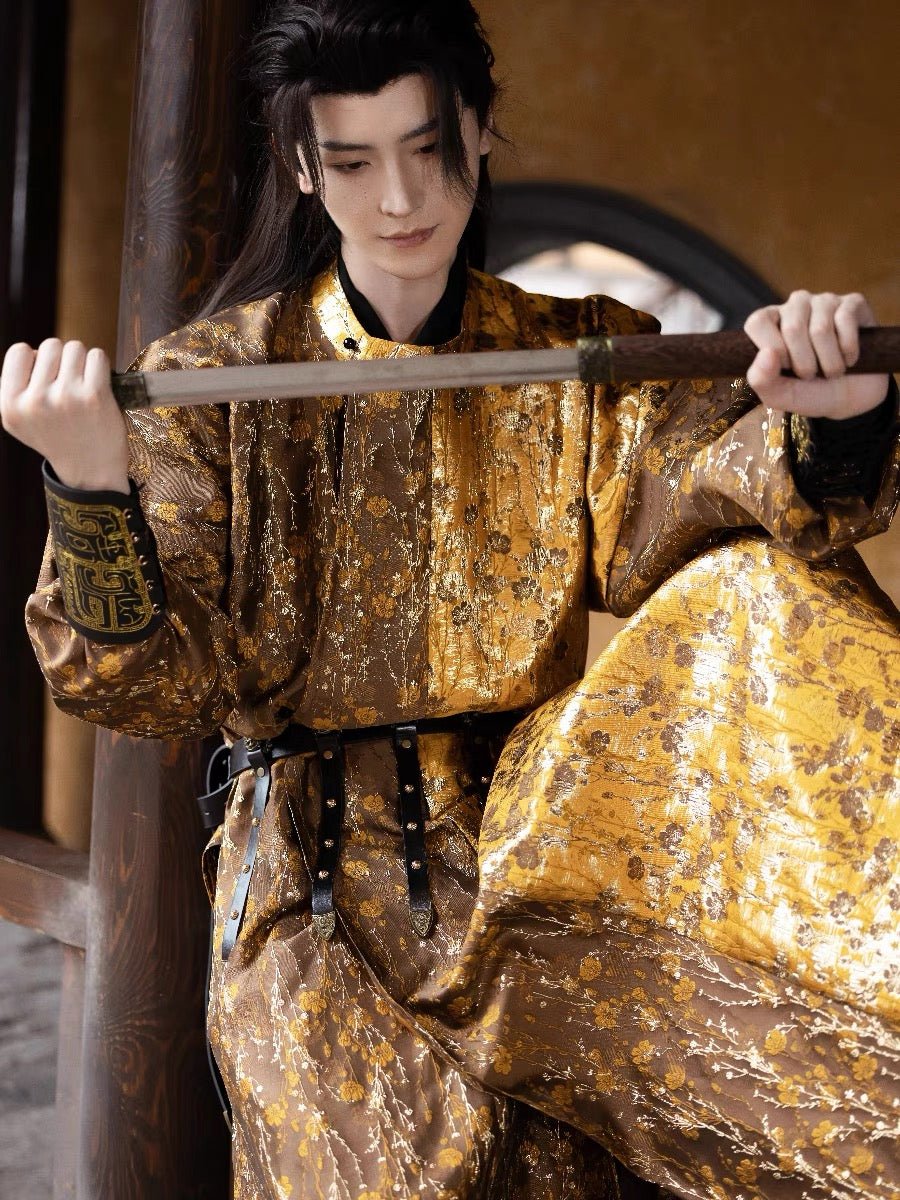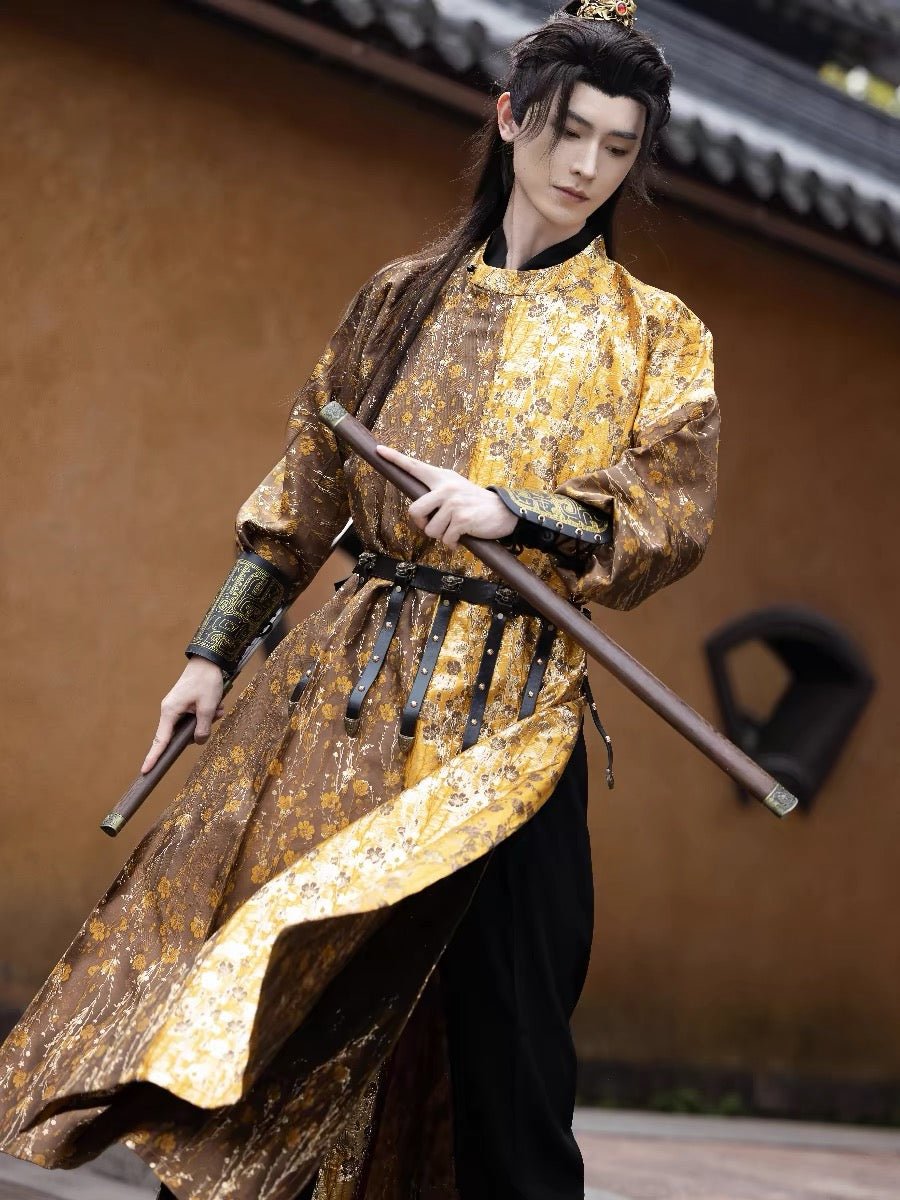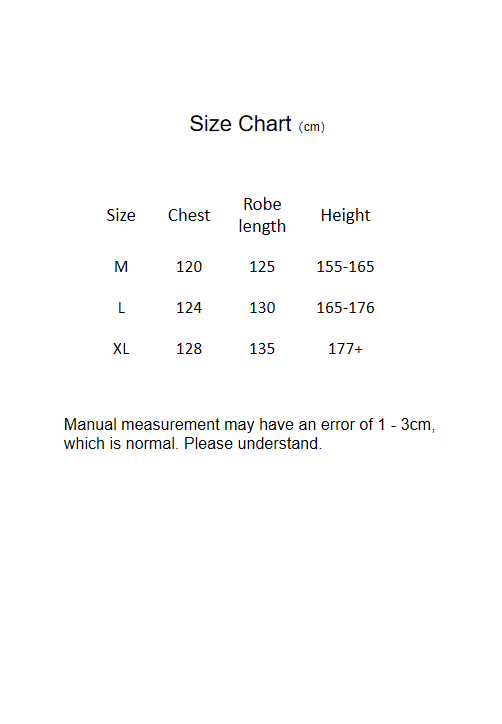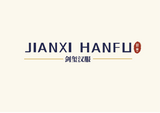The system of Tang Dynasty men's Hanfu (618-907 AD) was well-developed. It not only retained the traditional ritual attributes of Hanfu but also integrated practicality under the influence of Hu-style costumes (garments of non-Han ethnic groups)—a blend of elements that defined this iconic clothing style. Within the broader category of this traditional attire, there were three core styles, each serving distinct purposes and reflecting social hierarchies:
As the most prevalent style of Tang Dynasty men's Hanfu, the round-collar robe featured a closed round collar, with sleeve designs tailored to different needs and social roles. Narrow sleeves, influenced by Hu costumes, facilitated horseback riding, archery, and labor—making them popular among commoners and military personnel. Wide sleeves, by contrast, were worn daily by nobles and scholars, aligning with the elegant aesthetic of Tang-era men's Hanfu for elite groups.
The robe reached below the knees, with side slits for ease of movement—another practical detail that balanced functionality and tradition in this men’s attire. Fabrics varied sharply by social class: nobles used fine silk materials like ling (damask), luo (gauze), chou (satin), and duan (brocade), while commoners relied on coarse linen. A strict color hierarchy further distinguished ranks within Tang Dynasty men's Hanfu: purple robes for officials above Rank Three, crimson robes for those above Rank Five, and cyan robes for Rank Nine. Commoners mostly wore plain shades like white and gray. This hierarchical system is clearly recorded in The Old Book of Tang: Records of Costumes and Apparel.
Derived from traditional Hanfu long shirts, the Lan Shirt was a refined subset of Tang Dynasty men's Hanfu designed specifically as formal wear for scholars and students. It added a one-foot-wide horizontal band (lan) at the hem (usually in the same color or a lighter shade), symbolizing the ancient "upper garment + lower skirt" tradition that remained integral to Tang men’s Hanfu ceremonial designs.
True to the dignified demeanor of scholars, this style typically had wide sleeves, with fabrics ranging from fine cloth to thin silk. Colors tended to be plain (e.g., white, light cyan), and it was always paired with a waist belt—emphasizing the modesty and elegance expected of scholarly attire in the Tang era.
No set of Tang Dynasty men's Hanfu was complete without the Futou, its core matching headgear. Evolved from headscarves of the Eastern Han Dynasty (25-220 AD), the Futou adapted over time to become a defining accessory of this traditional men’s attire.
In the early Tang Dynasty, it was soft: made of silk cloth wrapped around the hair bun, with two ends hanging naturally—this style was common among both nobles and commoners in casual ensembles. After the mid-Tang period, "hard-foot futou" emerged: framed with iron wire or bamboo strips, its two ends could be straight or upturned (e.g., the "spreading-foot futou"). This sturdier design became an iconic symbol of official and noble Tang Dynasty men's Hanfu, while commoners continued to favor soft-foot futou for daily wear.

The design and use of Tang Dynasty men's Hanfu were shaped by three key principles:
-
Distinct hierarchical system: Colors, fabrics, and styles were tightly tied to social status—from purple official robes to linen commoner attire, clothing signaled rank at a glance.
-
Integration of Han and Hu elements: Features like narrow sleeves and side slits (borrowed from Hu costumes) blended seamlessly with traditional Hanfu silhouettes, reflecting the open cultural spirit of the Tang Dynasty in its men’s attire.
-
Balance of practicality and ritualism: This traditional clothing met daily activity needs (e.g., narrow sleeves for labor) while preserving the ceremonial function of Hanfu—embodying the era’s ability to merge utility with tradition.
This golden round-collar robe is a classic style of men's Hanfu from the Tang Dynasty. It is made of washed satin with antique-style patterns and crafted with gold-thread weaving technique, which delicately weaves and embroiders patterns onto the round-collar robe. The patterns stand out three-dimensionally on the robe, giving it an especially outstanding texture. Traditional patterns add structural layers and aesthetic appeal to the garment, and can also subtly modify the figure: when worn, it can make men appear tall, straight, and slender, as if their body proportions are cleverly "lengthened". This design that combines traditional charm and practical value allows people to own a Tang-style garment with high cost performance.
This round-collar robe employs the gold-thread weaving technique to meticulously weave and embroider floral patterns with leafy details onto the robe. The patterns, with plump flowers and spreading branches, are not only full of natural vitality but also imply the beautiful meaning of "prosperity with blooming flowers and lasting life", which is quite eye-catching and elegant. The golden-brown garment paired with three-dimensional and exquisite patterns makes the wearer look more mysterious and noble; additionally, matched with cuffs decorated with retro beast patterns, it adds a touch of valor and neatness. Beyond aesthetic value, such traditional patterns can also closely connect modern wearers with the cultural heritage of men's Hanfu in the Tang Dynasty, carrying the Tang people's earnest wishes for a smooth life and enduring good fortune.
To fully capture the essence of Tang Dynasty men's Hanfu, this round-collar robe pairs beautifully with several antique-style pieces:
- A plain white stand collar inner garment: its neckline adds subtle layers when exposed, echoing the layered silhouettes of traditional Tang men’s Hanfu.
- Wrist guards: these bring a touch of martial spirit, referencing the military and equestrian influences in some Tang-era styles.
- A waist belt: Opt for a double-button belt or a diéxiè belt (adorned with nine ornaments, which can hang small items like pouches—both practical and decorative, just like belts in historical Tang men’s attire).
- Hanfu boots: Neat, closed-toe boots complete the look, as footwear was a key detail in authentic Tang-era men’s ensembles.
- A wide-sleeved dàchǎng (outer robe): Draping this over the round-collar robe enhances the grandeur of the outfit, capturing the essence of formal Tang Dynasty men's Hanfu.
Wearing this ensemble feels like stepping back into Chang’an (the Tang capital) a thousand years ago. Its retro, eye-catching style stands out on the street—while staying true to the authenticity of Tang men’s traditional attire.
This set of clothes includes 1 round - collar robe, 1 nine - buckle belt, and wrist - guards.
Please note that the pattern print is not fixed, the position will be random and differ from the product images.
Fabric & Wash
Material: Polyester Recommend Hand-wash with your favorite mild detergent; Cold or warm water, maximum temperature 35°C. When washed, shake off any excess water and let them air dry. (Alternate: washing machine – put clothes into a soft mesh wash bag and run with gentle cycle).
About The Brand: 褚云令
A Trendy Lair for 200,000+ New Chinese Fashion Devotees
✅ Versatile Styles + Themed Sensations:From modernized cheongsam with Mandarin collar twists, to Tang-dynasty-inspired blouses (with hidden pockets!), and mythical beast-embroidered trench coats—we bridge heritage and hustle. Must-grab collections:
-
“Cloud-Dragon Ascent”: A suit set with cloud-pattern embroidery—dominate the office in regal flair.
-
“Crane Bearing Branches”: A slit cheongsam dress with crane motifs—turn heads at dinners or gatherings.
- Viral “Kylin Chasing Moon” sweatshirt: Subtle Kylin patterns + gradient prints—storm the streets in low-key cool (spotted at Guofeng pop-ups!).
✅ Design Edge:Ditch “stuffy tradition”! We use sharp cuts (asymmetric hems, cinched waists) and bold color clashes (navy×gold, pine green×lavender) to make Guofeng sleek. For example:
- Spring/autumn: Acetate satin + suede panels—structured yet luxe.
- Summer drops: Tencel-linen blends—breezy, sweat-resistant, and office-approved!
✨ Smart Pricing:80% of items sit between $75–$149! A full Cloud-Dragon suit costs under $175 (cheaper than fast-fashion “basics”), while a draped cheongsam starts at $99—fabric drape rivals designer labels (just check buyer reviews—detail fanatics rave about stitch precision!).
📊 Hardcore Stats:As a 2-crown shop, we’ve served 200,000+ customers. In 2025, monthly sales rank TOP 3 in the New Chinese fashion category! Our “Cloud-Embroidered Shirt” moves 800+ units monthly—warehouse teams work overtime, proving hype = quality.
🌟 Glowing Testimonials:
- “Bought 4 pieces! The gold detailing on Cloud-Dragon looks designer—colleagues thought it cost $450+!”
- “Fabric blew me away! The tencel-linen shirt is SO airy for summer—my boss asked where I got it!”
- “Cultural swag overload! The Kylin sweatshirt’s subtle patterns are fire—I got stopped at a festival!”
Here, Guofeng isn’t just costumes—it’s daily armor. Whether you’re a New Chinese newbie or a streetwear vet, Chu Yun Ling’s “chic + wearable” designs let Eastern elegance slide into boardrooms, cafes, and concerts. With 200,000+ fans on board, isn’t it your turn to rock timeless style?
